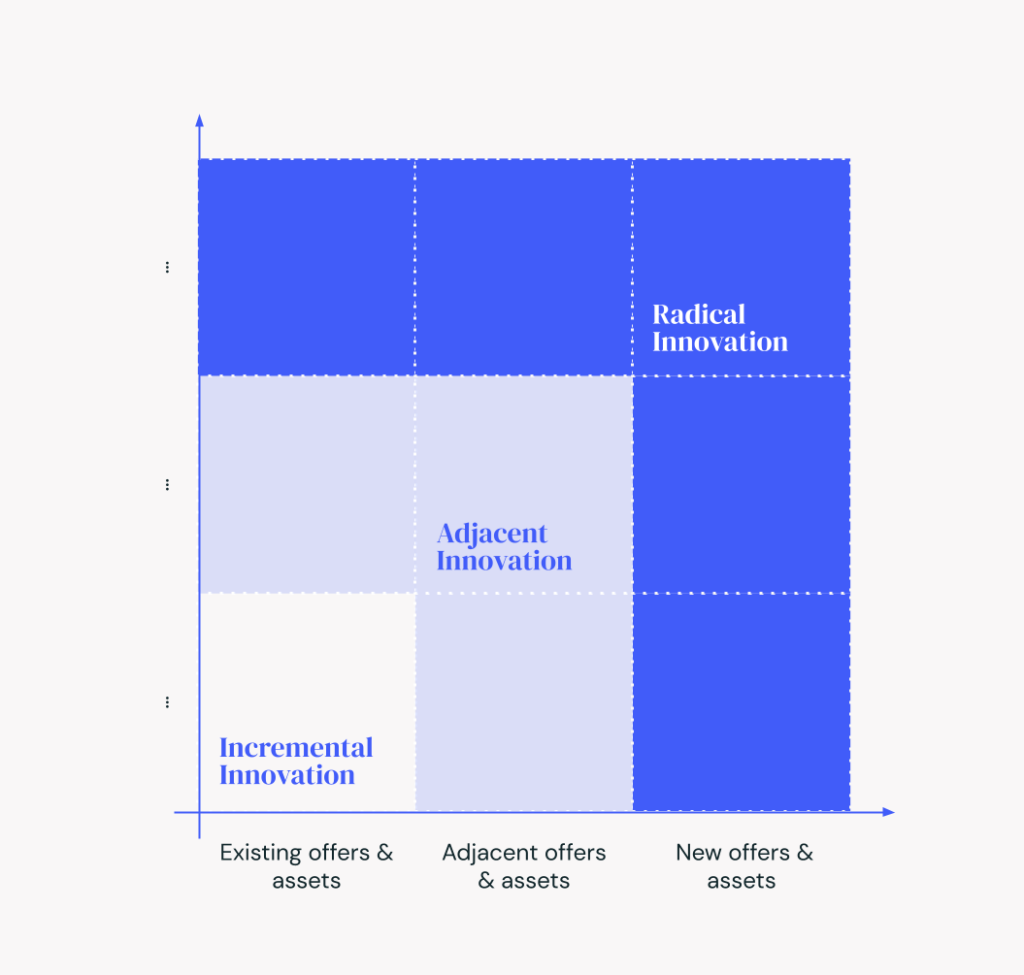In the previous articles of the IPM series, we introduced the topic of IPM and shared four different ways to map your projects. In this post, we’ll be talking about the most common pitfalls organizations encounter when implementing innovation portfolio management.
The potential pitfalls of innovation portfolio management
An overview of the things that could go wrong will come in handy as you dive deeper into mapping your innovation projects.
1. Including daily business tasks in the mapping
An overflow of elements in your mapping will cloud your overview; prioritizing and interpreting relevant information and comparing your innovation projects will become challenging.
To avoid visual clutter, the first step is to set a clear definition of what an innovation project is. Aligning on this company-wide will be an internal challenge, as different stakeholders or departments might have different interpretations of the term. But going the extra mile to ensure everyone’s rowing in the same direction is important – not only for the mapping of projects, but as a company best-practice.
Differentiate your daily tasks from innovation projects
Distinguishing between tasks and innovation projects is how you avoid mapping conflicts between them. While every organization defines an innovation project differently, we have some guidelines on what we think an innovation project is (and what it isn’t).
Most times, innovation projects involve a clear start and end date. They are implemented to generate a product, service or process that differs from existing ones, resulting in serving a customer segment different from the ones currently served.
Understanding what an innovation project is will help you gain clarity of what it’s not — continuous optimization projects, improvement of existing offerings, or serving existing segments.
This definition is fluid, depending on your organization’s ambitions. As your organization matures in its innovation activities, this defition should evolve as well.
2. Misinterpreting visions as strategic directions
Strategic objectives are always more tactical than overall visions. Once again, definitions will come to your aid, and avoid unwanted overlaps: begin with clarifying the difference between values, visions, missions, strategic objectives, and activities.
If strategic objectives are written too broadly (ie. more of a vision) then you are drawing statements like “Increasing awareness of the brand”. A generic statement means several projects can fall under it, in turn, not helping you understand whether your projects are supporting an objective and failing the purpose of the innovation portfolio management exercise.
As you move forward, if you see most projects are falling under the same strategic objective, there’s a high chance your strategic objective is too broad. Narrowing down your strategic goal can be done by breaking it down into specific areas that will become your new and improved strategic objectives.
3. Misinformed risk levels
It can be hard to tell the difference between project risks, but investing in placing them in the right innovation ambitions will help the overall mapping outcome. Take for example your most ambitious projects, they should be funded and staffed very differently from core projects since they’ll require different setups, timeline, and skill sets.
To ensure that your mapping offers a fair representation of your risk, we recommend you use our Innovation Landscape tool to clarify your project’s ambition.

4. Treating IPM as a one-time project
As with all your “firsts”, the first time mapping your projects will require extra effort, and will most likely also offer AHA-moments about your team’s work and priorities. However, to continuously benefit from the mapping, it has to be revisited and leveraged as one of your go-to tools.
Re-prioritization and alignment exercises should always involve the relevant IPM view. Continuously tracking projects, their evolution and learnings, you can optimize long-term results by improving projects and decision-making.
So that IPM doesn’t turn into a one-time fling, semestral or annual follow-up mappings should happen depending on the number of projects in the pipeline. Some digital tools (you might want to check out iTonics) can be helpful to make the process more efficient.
5. A single project with multiple strategic priorities
We can all be tempted to say a single project serves multiple strategic priorities (especially when this reasoning can justify or validate the implementation of that project). But, when too many projects are linked to multiple strategic priorities, it becomes close to impossible to discover which priorities are receiving too much attention, and which are in desperate need of some.
To keep your mapping sharp and coherent, pinpoint a primary strategic objective and separate it from secondary ones. Make sure your project is linked only to your primary objective. This will create a network of clear links, avoid overlaps, and pave the way for richer insights from the mappings.
6. Force fitting a project under a strategic priority
Just like connecting one project with multiple strategic objectives can mess with your insights, forcing a project under an objective can also have a negative impact. Yes, you will still get mapping insights, but these will be skewed truths based on a forced fit.
To avoid tampering with your own mapping, you can bring in a neutral facilitator during mapping workshops. This person should be in charge of pointing out projects that are not a good fit under a strategic objective from an unbiased perspective.
7. Lack of clarity on project scope
Making sure you’re scoping projects the right way is a good practice for all aspects of your company, but it’s particularly important when it comes to IPM. Scope accuracy when managing your innovation portfolio will be the cornerstone of the accuracy of your entire portfolio, and of the outcomes of the entire IPM exercise.
To make sure your scope is clear enough, play close attention to the degree of ambition you attribute your projects. If you find your team struggling to categorize a project’s ambition, taking a step back and discussing the initial scope is always a good approach to set up your projects for success.
Ready to get started?
Talk is cheap — implementing IPM is not just about getting your theory right, but being ready for the challenges you may come across when putting it into practice.
To avoid these seven pitfalls and other potential challenges, make sure someone is in charge of leading the exercise, even better if they come from your innovation department. Depending on where the exercise is taking place, the corresponding department heads should also be involved along with project leads, who will be in charge of feeding you the right information.
Check out our other two blog posts on innovation portfolio management

Make bigger moves
Align your current and future products with your growth ambitions. Structure your portfolio to win by making actionable choices with the right product mix. Set up an agile portfolio management system with simple and effective governance.


